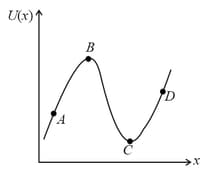HARD
Earn 100
The potential energy of a particle of mass , moving in the plane, is given by and being in metres. Initially at , the particle is at the origin and has velocity . Then:
(a)the speed of the particle at , is
(b)the acceleration of the particle is .
(c)the direction of acceleration of the particle is perpendicular to its direction of motion, initially.
(d)the direction of acceleration of the particle is along the direction of motion, initially.
50% studentsanswered this correctly
Important Questions on Work, Energy and Power
MEDIUM
EASY
EASY
MEDIUM
MEDIUM
EASY
EASY

EASY
HARD
MEDIUM
The graphs below show the magnitude of the force on a particle as it moves along the positive -axis from the origin to . The force is parallel to the -axis and conservative. The maximum magnitude has the same value for all graphs. Rank the situations according to the change in the potential energy associated with the force, least (or most negative) to greatest (or most positive).

EASY
EASY
EASY
MEDIUM
| Column-I | Column-II | ||
| (a) | (i) | ||
| (b) | (ii) | ||
| (c) | (iii) | ||
| (d) | (iv) | ||
EASY
HARD
EASY
EASY
MEDIUM
MEDIUM

